2010 JEEP LIBERTY traction control
[x] Cancel search: traction controlPage 341 of 522
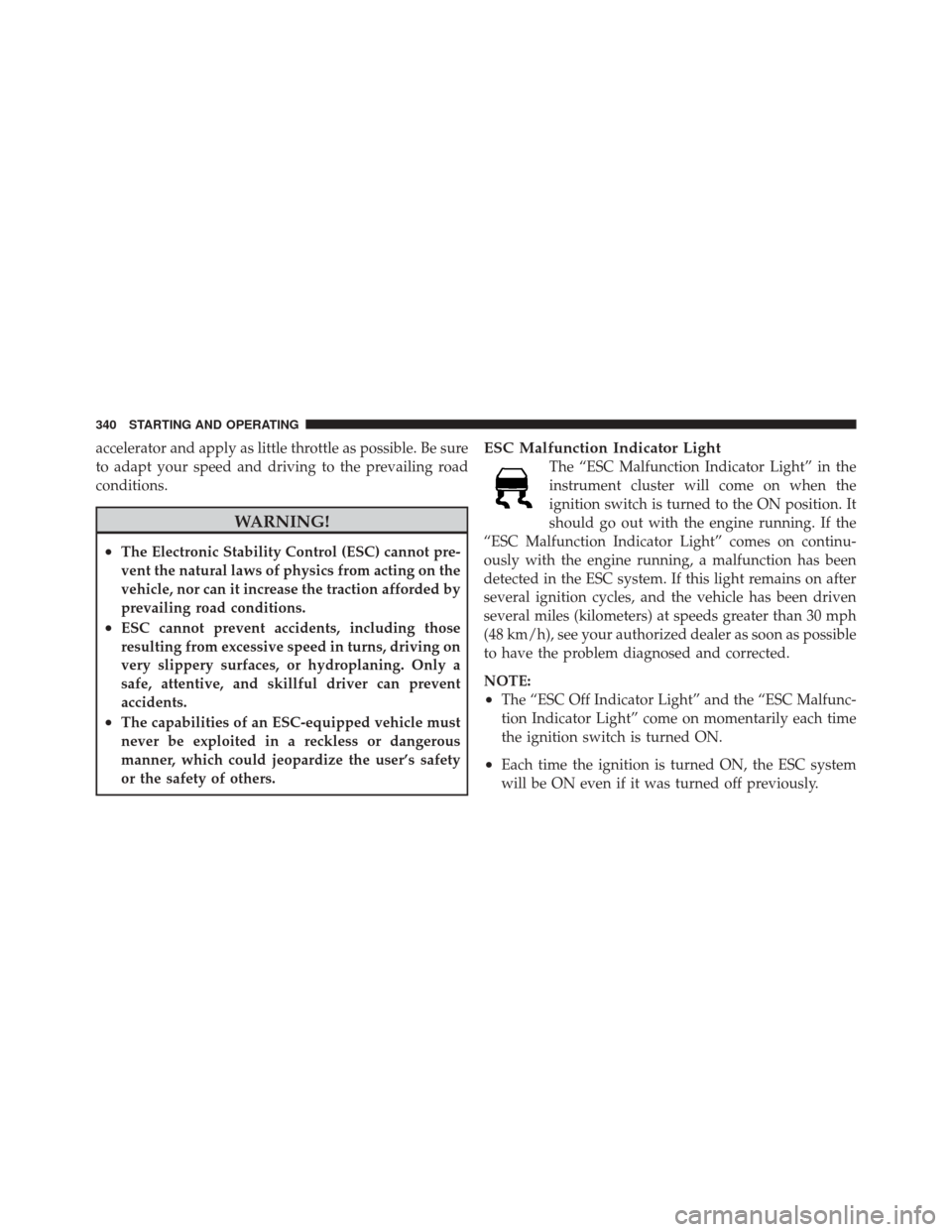
accelerator and apply as little throttle as possible. Be sure
to adapt your speed and driving to the prevailing road
conditions.
WARNING!
•The Electronic Stability Control (ESC) cannot pre-
vent the natural laws of physics from acting on the
vehicle, nor can it increase the traction afforded by
prevailing road conditions.
•ESC cannot prevent accidents, including those
resulting from excessive speed in turns, driving on
very slippery surfaces, or hydroplaning. Only a
safe, attentive, and skillful driver can prevent
accidents.
•The capabilities of an ESC-equipped vehicle must
never be exploited in a reckless or dangerous
manner, which could jeopardize the user’s safety
or the safety of others.
ESC Malfunction Indicator Light
The “ESC Malfunction Indicator Light” in the
instrument cluster will come on when the
ignition switch is turned to the ON position. It
should go out with the engine running. If the
“ESC Malfunction Indicator Light” comes on continu-
ously with the engine running, a malfunction has been
detected in the ESC system. If this light remains on after
several ignition cycles, and the vehicle has been driven
several miles (kilometers) at speeds greater than 30 mph
(48 km/h), see your authorized dealer as soon as possible
to have the problem diagnosed and corrected.
NOTE:
•The “ESC Off Indicator Light” and the “ESC Malfunc-
tion Indicator Light” come on momentarily each time
the ignition switch is turned ON.
•Each time the ignition is turned ON, the ESC system
will be ON even if it was turned off previously.
340 STARTING AND OPERATING
Page 343 of 522

NOTE:To improve the vehicle’s traction when driving
with snow chains, or when starting off in deep snow,
sand, or gravel, it may be desirable to switch to the
“Partial Off” mode by momentarily pressing the “ESC
Off” button. Once the situation requiring “Partial Off”
mode is overcome, turn ESC back on by momentarily
pressing the “ESC Off” button. This may be done while
the vehicle is in motion.
Full Off — Four-Wheel Drive Vehicles in 4WD High
and 4WD Low Range
The “Full Off” mode is intended for off-highway and
off-road use when ESC stability features could inhibit
vehicle maneuverability due to trail conditions.
The “ESC Off” button is located in the lower switch bank
below the climate control panel. To enter “Full Off”
mode, press and hold the “ESC Off” button for five
seconds while the vehicle is stopped with the engine
running. After five seconds, the “ESC Off Indicator Light” will illuminate and an “ESC OFF” message will
appear in the odometer. Press and release the trip odom-
eter button located on the instrument cluster to turn off
this message.
In this mode, ESC and TCS are turned off (except for the
“limited slip” feature described in the TCS section) until
the vehicle reaches a speed of 40 mph (64 km/k). At
speeds over 40 mph (64 km/k), the system automatically
switches to “Partial Off” mode, described above. When
the vehicle speed returns to less than 35 mph (56 km/h),
the ESC system will return to “Full Off” mode. The “ESP
Off Indicator Light” is always illuminated when ESC is
off. To turn ESC on again, momentarily press the “ESC
Off” button. This will restore the normal “ESC On” mode
of operation.
342 STARTING AND OPERATING
Page 361 of 522

WARNING! (Continued)
•Failure to equip your vehicle with tires having
adequate speed capability can result in sudden tire
failure and loss of vehicle control.
CAUTION!
Replacing original tires with tires of a different size
may result in false speedometer and odometer read-
ings.
TIRE CHAINS
Use only compact chains, or other traction aids that meet
SAE type “Class S” specifications. Chains must be the
proper size for the vehicle, as recommended by the chain
manufacturer. In addition, only install tire chains on
P225/75R16 or smaller tires.
CAUTION!
To avoid damage to your vehicle, tires, or chains,
observe the following precautions:
•Do not use tire chains on vehicles equipped with
tires other than P225/75R16 or smaller tires. There
may not be adequate clearance for the chains and
you are risking structural or body damage to your
vehicle.
•Because of limited chain clearance between tires
and other suspension components, it is important
that only chains in good condition are used. Bro-
ken chains can cause serious vehicle damage. Stop
the vehicle immediately if noise occurs that could
suggest chain breakage. Remove the damaged
parts of the chain before further use.(Continued)
360 STARTING AND OPERATING
Page 498 of 522
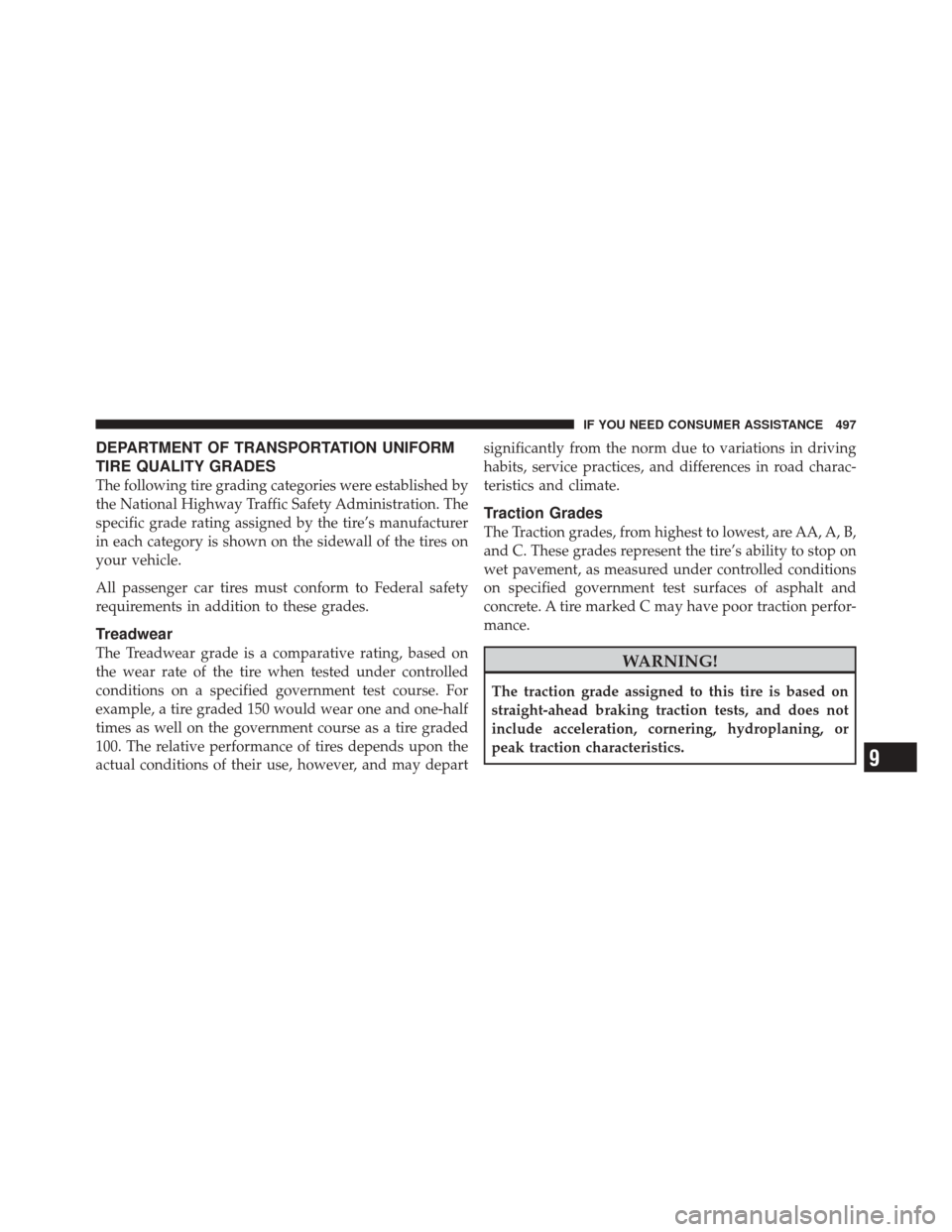
DEPARTMENT OF TRANSPORTATION UNIFORM
TIRE QUALITY GRADES
The following tire grading categories were established by
the National Highway Traffic Safety Administration. The
specific grade rating assigned by the tire’s manufacturer
in each category is shown on the sidewall of the tires on
your vehicle.
All passenger car tires must conform to Federal safety
requirements in addition to these grades.
Treadwear
The Treadwear grade is a comparative rating, based on
the wear rate of the tire when tested under controlled
conditions on a specified government test course. For
example, a tire graded 150 would wear one and one-half
times as well on the government course as a tire graded
100. The relative performance of tires depends upon the
actual conditions of their use, however, and may departsignificantly from the norm due to variations in driving
habits, service practices, and differences in road charac-
teristics and climate.
Traction Grades
The Traction grades, from highest to lowest, are AA, A, B,
and C. These grades represent the tire’s ability to stop on
wet pavement, as measured under controlled conditions
on specified government test surfaces of asphalt and
concrete. A tire marked C may have poor traction perfor-
mance.
WARNING!
The traction grade assigned to this tire is based on
straight-ahead braking traction tests, and does not
include acceleration, cornering, hydroplaning, or
peak traction characteristics.
9
IF YOU NEED CONSUMER ASSISTANCE 497
Page 505 of 522
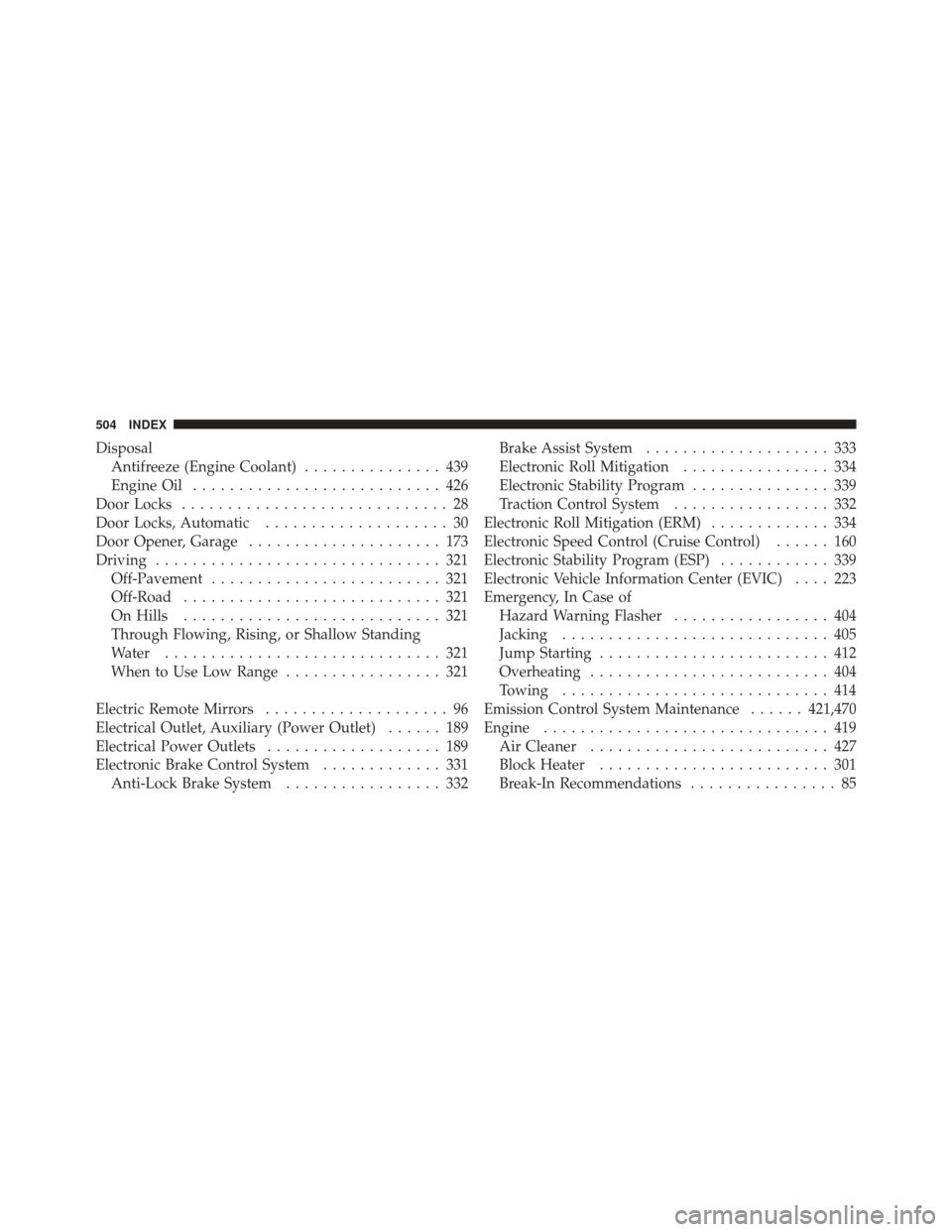
DisposalAntifreeze (Engine Coolant) ............... 439
Engine Oil ........................... 426
Door Locks ............................. 28
Door Locks, Automatic .................... 30
Door Opener, Garage ..................... 173
Driving ............................... 321
Off-Pavement ......................... 321
Off-Road ............................ 321
On Hills ............................ 321
Through Flowing, Rising, or Shallow Standing
Water .............................. 321
When to Use Low Range ................. 321
Electric Remote Mirrors .................... 96
Electrical Outlet, Auxiliary (Power Outlet) ...... 189
Electrical Power Outlets ................... 189
Electronic Brake Control System ............. 331
Anti-Lock Brake System ................. 332 Brake Assist System
.................... 333
Electronic Roll Mitigation ................ 334
Electronic Stability Program ............... 339
Traction Control System ................. 332
Electronic Roll Mitigation (ERM) ............. 334
Electronic Speed Control (Cruise Control) ...... 160
Electronic Stability Program (ESP) ............ 339
Electronic Vehicle Information Center (EVIC) .... 223
Emergency, In Case of Hazard Warning Flasher ................. 404
Jacking ............................. 405
Jump Starting ......................... 412
Overheating .......................... 404
Towing ............................. 414
Emission Control System Maintenance ......421,470
Engine ............................... 419
Air Cleaner .......................... 427
Block Heater ......................... 301
Break-In Recommendations ................ 85
504 INDEX
Page 511 of 522
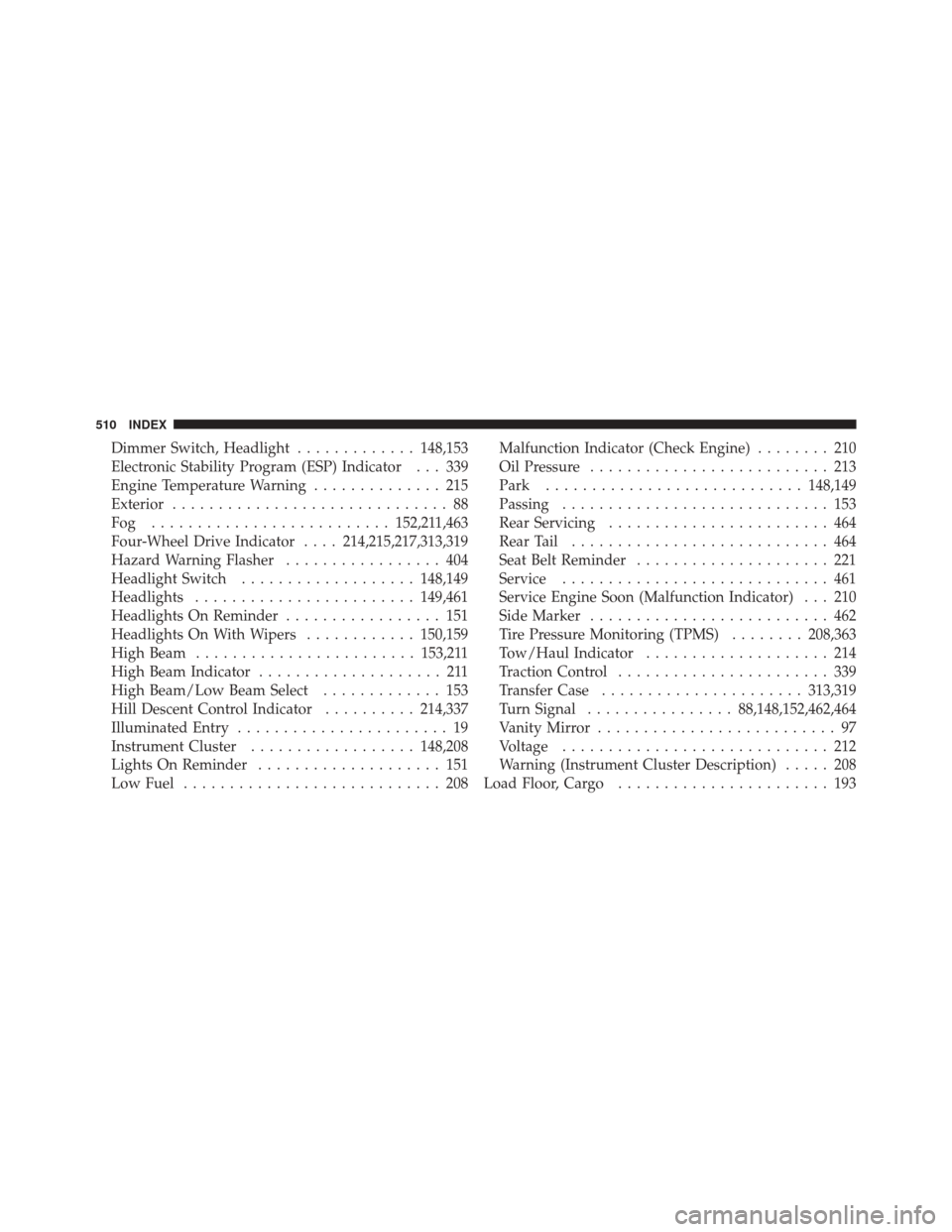
Dimmer Switch, Headlight.............148,153
Electronic Stability Program (ESP) Indicator . . . 339
Engine Temperature Warning .............. 215
Exterior .............................. 88
Fog .......................... 152,211,463
Four-Wheel Drive Indicator ....214,215,217,313,319
Hazard Warning Flasher ................. 404
Headlight Switch ................... 148,149
Headlights ........................ 149,461
Headlights On Reminder ................. 151
Headlights On With Wipers ............150,159
High Beam ........................ 153,211
High Beam Indicator .................... 211
High Beam/Low Beam Select ............. 153
Hill Descent Control Indicator ..........214,337
Illuminated Entry ....................... 19
Instrument Cluster .................. 148,208
Lights On Reminder .................... 151
Low Fuel ............................ 208 Malfunction Indicator (Check Engine)
........ 210
Oil Pressure .......................... 213
Park ............................ 148,149
Passing ............................. 153
Rear Servicing ........................ 464
Rear Tail ............................ 464
Seat Belt Reminder ..................... 221
Service ............................. 461
Service Engine Soon (Malfunction Indicator) . . . 210
Side Marker .......................... 462
Tire Pressure Monitoring (TPMS) ........208,363
Tow/Haul Indicator .................... 214
Traction Control ....................... 339
Transfer Case ...................... 313,319
Turn Signal ................ 88,148,152,462,464
Vanity Mirror .......................... 97
Voltage ............................. 212
Warning (Instrument Cluster Description) ..... 208
Load Floor, Cargo ....................... 193
510 INDEX
Page 519 of 522
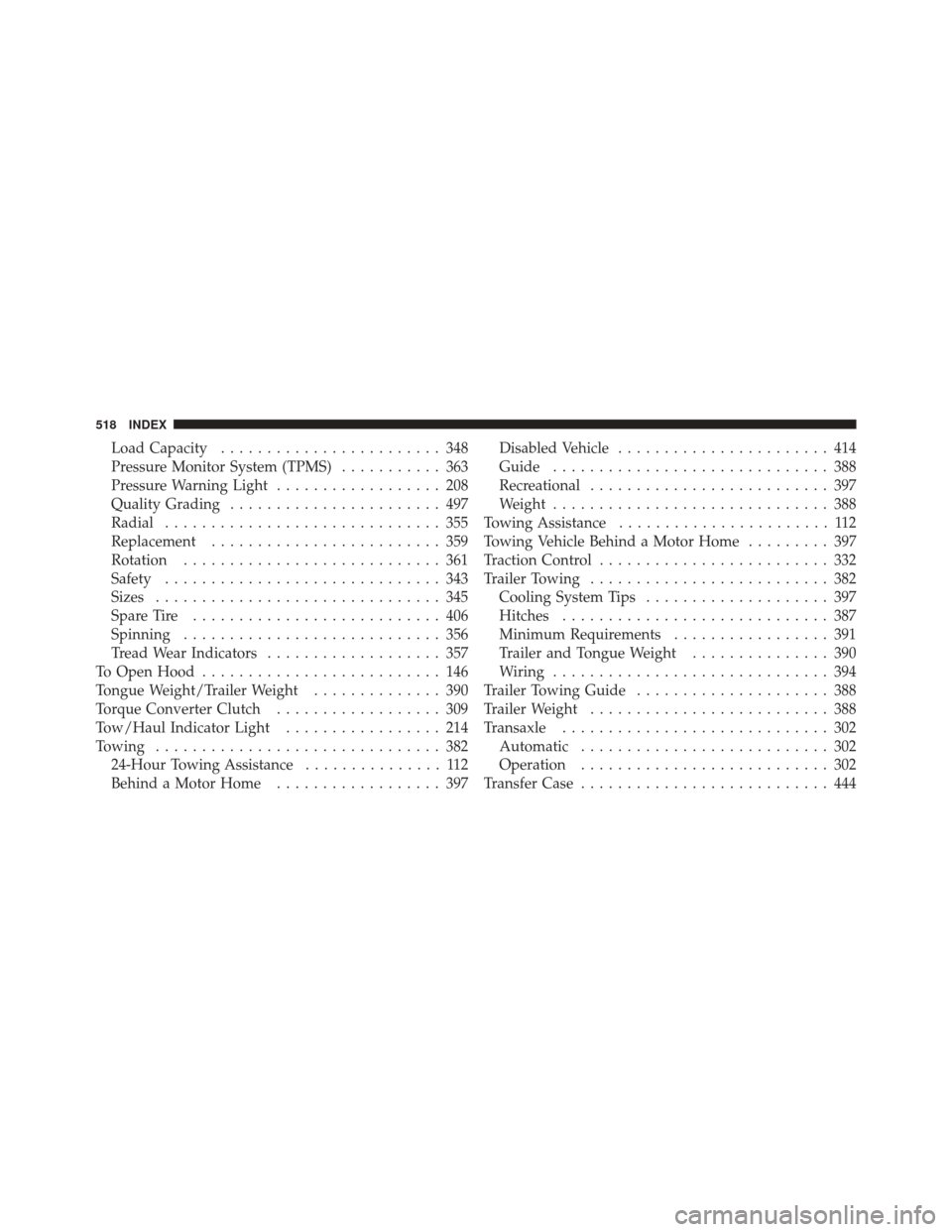
Load Capacity........................ 348
Pressure Monitor System (TPMS) ........... 363
Pressure Warning Light .................. 208
Quality Grading ....................... 497
Radial .............................. 355
Replacement ......................... 359
Rotation ............................ 361
Safety .............................. 343
Sizes ............................... 345
Spare Tire ........................... 406
Spinning ............................ 356
Tread Wear Indicators ................... 357
To Open Hood .......................... 146
Tongue Weight/Trailer Weight .............. 390
Torque Converter Clutch .................. 309
Tow/Haul Indicator Light ................. 214
Towing ............................... 382
24-Hour Towing Assistance ............... 112
Behind a Motor Home .................. 397 Disabled Vehicle
....................... 414
Guide .............................. 388
Recreational .......................... 397
Weight .............................. 388
Towing Assistance ....................... 112
Towing Vehicle Behind a Motor Home ......... 397
Traction Control ......................... 332
Trailer Towing .......................... 382
Cooling System Tips .................... 397
Hitches ............................. 387
Minimum Requirements ................. 391
Trailer and Tongue Weight ............... 390
Wiring .............................. 394
Trailer Towing Guide ..................... 388
Trailer Weight .......................... 388
Transaxle ............................. 302
Automatic ........................... 302
Operation ........................... 302
Transfer Case ........................... 444
518 INDEX